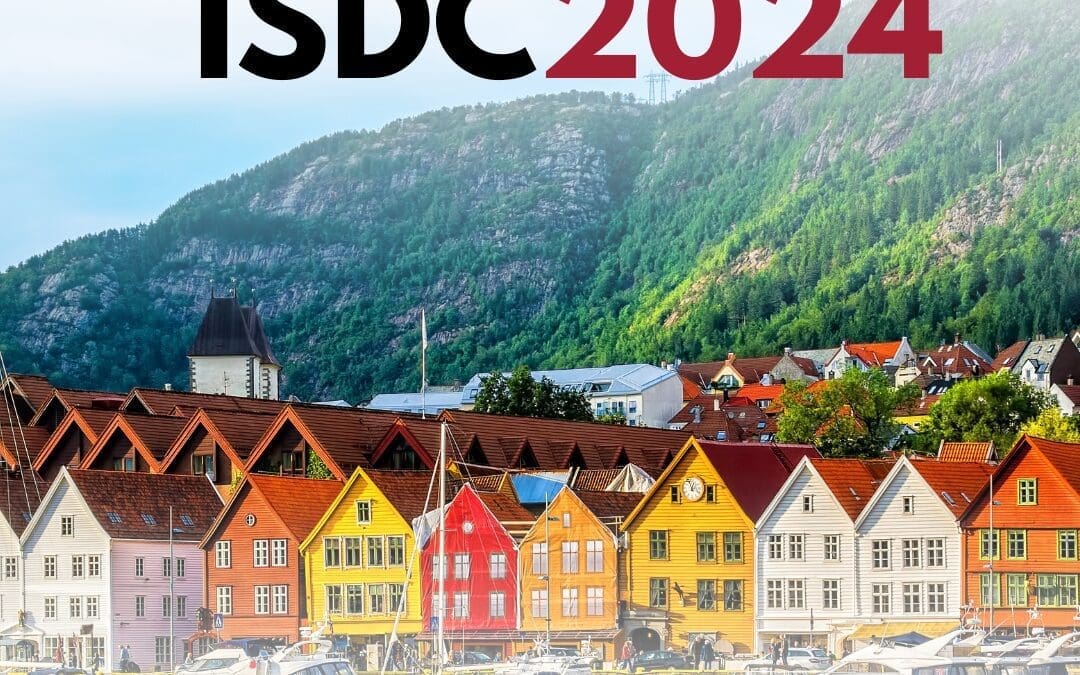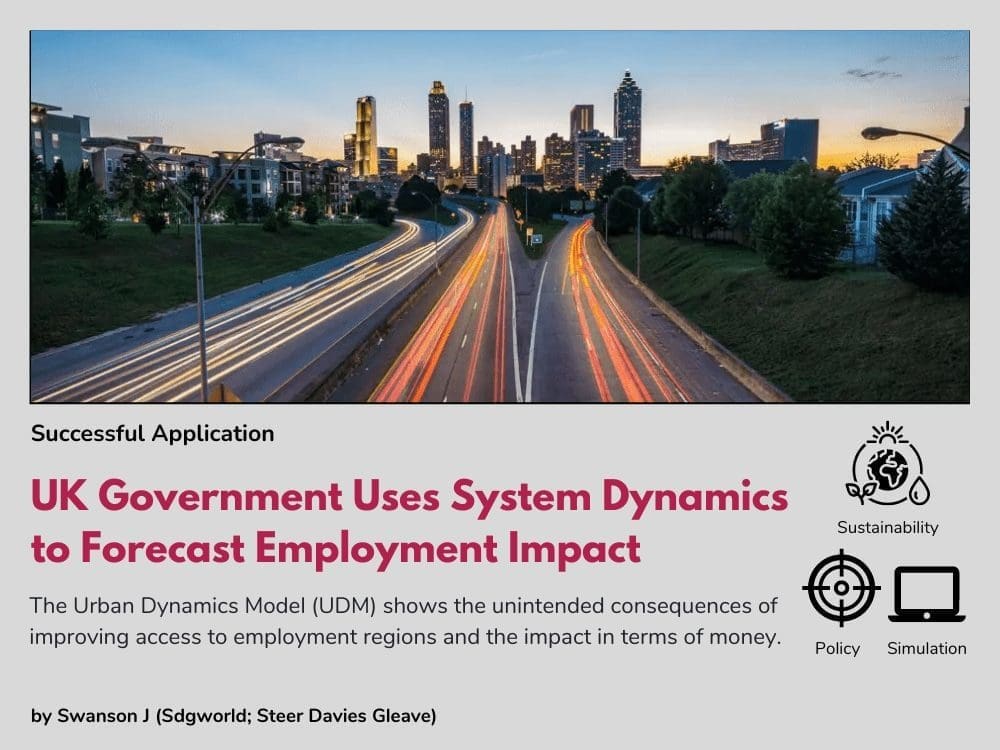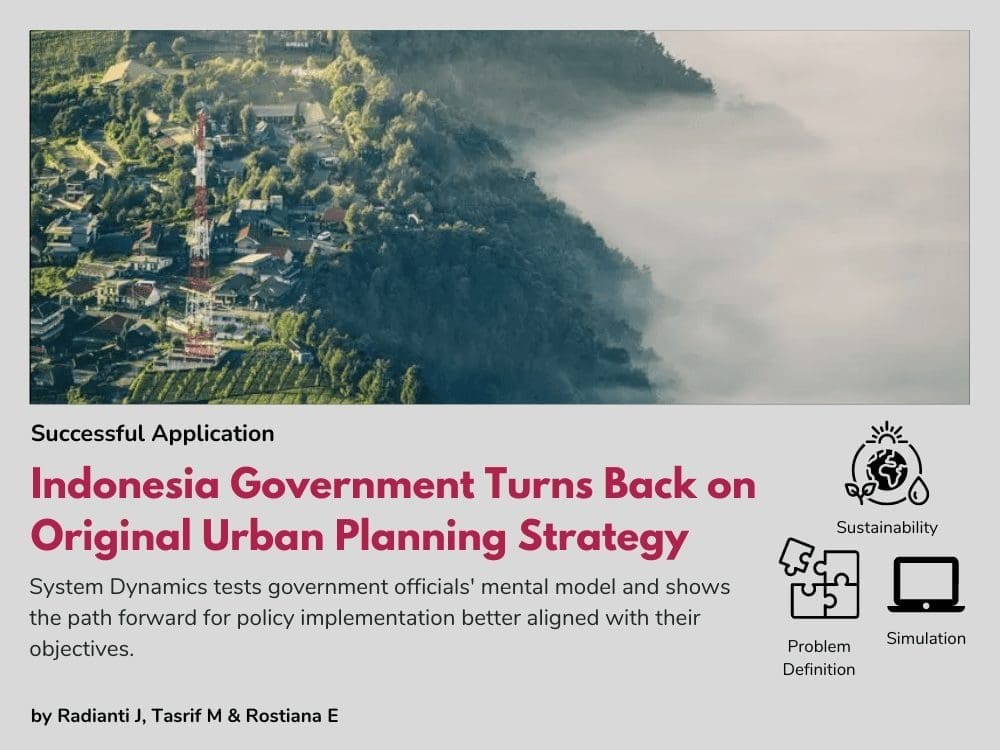UK Government Uses System Dynamics to Forecast Employment Impact
The Urban Dynamic Model (UDM) is a simulation of how transport interacts with population, employment and land-use over long periods of time, typically ten years or more. It was developed to help understand how transport could contribute to economic regeneration by improving the ability of employers to recruit a workforce and their access to customers and suppliers, and by improving access to employment opportunities.
For example, the vicious circle of congestion is familiar to us all but is almost impossible to capture in traditional models. In short, the cycle includes improved transport which reduces travel time, making businesses easier to access for customers, generating increased employment, leading to more transport activity and increased congestion.
The UDM was developed over a number of years, beginning with a fairly simple model built in 2000. This was used in one of a series of large scale transport studies commissioned by the government at the time. Its role at that time was to test the regeneration claims being made for a proposed by-pass that would have passed through an area of outstanding natural beauty. Models of this type must be able to represent the spatial characteristics of the study area, usually using a zone structure, and the road and public transport links connecting the zones together. Other applications followed, and then in 2005 we were commissioned by the Department for transport to carry out a study into the impact of transport on business location decisions. Current guidance from the Department for Transport emphasises the wider role of transport in supporting the economy, but also points to the need for reducing carbon dioxide emissions.
The UDM is generic, and has been applied widely in the UK with local authorities. Conclusions vary from one application to another, but some of the findings we have reported include measures to generate employment can appear to have a significant effect if examined very locally, but we often find that some employment is transferred from elsewhere, and the net effect can be less than might first appear, city centres remain the best locations for many types of employer because they provide the best access to a workforce and bring ‘agglomeration’ benefits that employers enjoy by being clustered together. Studies of major programmes of transport investment typically involve expenditure of tens or hundreds of millions of pounds. The measured benefits are usually expressed in money, and expressing both the social and economic impacts of investment and can also run to hundreds of millions of pounds.
| Client | UK local authorities |
|---|---|
| Authors/Consultants | Swanson J (Sdgworld; Steer Davies Gleave) |
More Information
| For more information on this case, please contact John Swanson at Sdgworld, or see this link. |
OTHER SUCCESSFUL APPLICATIONS
System Dynamics Helps Evaluate Anticipatory Action on Cholera Outbreaks
Humanitarian agencies encourage anticipatory action in disaster response to cholera outbreaks in the Democratic Republic of Congo.
Management Design for Planted Forests in Japan Using System Dynamics
Hanno City in Saitama Prefecture used a system dynamics model to enable detailed analysis of labor requirements and changes in forest conditions.
Solving Bottlenecks in Dairy Production Facilities with System Dynamics
FriedslandCampina employed system dynamics to strategically enhance production efficiency in the midst of factory merging.
Upcoming Events

2024 International System Dynamics Conference
The International System Dynamics Conference is coming to Bergen! Save the date: August 4-8, 2024. We hope to see you there! #ISDC2024
Recent Posts
How Did En-ROADS Get 755,000 users? Lessons on Modeling, Interface Design, and Facilitation
This article discusses the En-ROADS climate model, detailing its robust modeling, intuitive interface design, effective facilitation, and strategic policy engagement for global impact.
Society Governance Updates
New System Dynamics Society leadership
Call for Presenters: Seminar Series
Share your insights in the System Dynamics Society Seminar Series. Submit your proposal and join a global community of experts
Join us
OTHER SUCCESSFUL APPLICATIONS
System Dynamics Helps Evaluate Anticipatory Action on Cholera Outbreaks
Humanitarian agencies encourage anticipatory action in disaster response to cholera outbreaks in the Democratic Republic of Congo.
Management Design for Planted Forests in Japan Using System Dynamics
Hanno City in Saitama Prefecture used a system dynamics model to enable detailed analysis of labor requirements and changes in forest conditions.
Solving Bottlenecks in Dairy Production Facilities with System Dynamics
FriedslandCampina employed system dynamics to strategically enhance production efficiency in the midst of factory merging.
Recent Posts
How Did En-ROADS Get 755,000 users? Lessons on Modeling, Interface Design, and Facilitation
This article discusses the En-ROADS climate model, detailing its robust modeling, intuitive interface design, effective facilitation, and strategic policy engagement for global impact.
Society Governance Updates
New System Dynamics Society leadership
Call for Presenters: Seminar Series
Share your insights in the System Dynamics Society Seminar Series. Submit your proposal and join a global community of experts
Upcoming Events

2024 International System Dynamics Conference
The International System Dynamics Conference is coming to Bergen! Save the date: August 4-8, 2024. We hope to see you there! #ISDC2024
Indonesia Government Turns Back on Original Urban Planning Strategy
In pioneering spatial planning management for metropolitan cities, the Ministry of Human Settlements and Regional Infrastructures Development of the Republic of Indonesia, started a project to build a computer simulation on spatial planning. The pilot project was situated in Semarang, the capital city of Central Java, Indonesia.
The aim of the project was to understand the impact of metropolitan growth and spatial planning on essential indicators of urban life such as economic growth, land usages and industry development. The impact of population growth was the central focus in this project. Population growth was explored to predict to which extent additional facilities such as lands for industry development and transportation infrastructure were needed.
The model showed that almost all policies directed at raising economic growth also increased the population number.
The conclusion of the project is that any policy in the field of spatial planning should anticipate effects on the population sector and mitigate planning accordingly.
| Client | Ministry of Human Settlements and Regional Infrastructures Development, Indonesia |
|---|---|
| Authors/Consultants | Radianti J, Tasrif M, Rostiana E |
OTHER SUCCESSFUL APPLICATIONS
System Dynamics Helps Evaluate Anticipatory Action on Cholera Outbreaks
Humanitarian agencies encourage anticipatory action in disaster response to cholera outbreaks in the Democratic Republic of Congo.
Management Design for Planted Forests in Japan Using System Dynamics
Hanno City in Saitama Prefecture used a system dynamics model to enable detailed analysis of labor requirements and changes in forest conditions.
Solving Bottlenecks in Dairy Production Facilities with System Dynamics
FriedslandCampina employed system dynamics to strategically enhance production efficiency in the midst of factory merging.
Upcoming Events

2024 International System Dynamics Conference
The International System Dynamics Conference is coming to Bergen! Save the date: August 4-8, 2024. We hope to see you there! #ISDC2024
Recent Posts
How Did En-ROADS Get 755,000 users? Lessons on Modeling, Interface Design, and Facilitation
This article discusses the En-ROADS climate model, detailing its robust modeling, intuitive interface design, effective facilitation, and strategic policy engagement for global impact.
Society Governance Updates
New System Dynamics Society leadership
Call for Presenters: Seminar Series
Share your insights in the System Dynamics Society Seminar Series. Submit your proposal and join a global community of experts
Join us
OTHER SUCCESSFUL APPLICATIONS
System Dynamics Helps Evaluate Anticipatory Action on Cholera Outbreaks
Humanitarian agencies encourage anticipatory action in disaster response to cholera outbreaks in the Democratic Republic of Congo.
Management Design for Planted Forests in Japan Using System Dynamics
Hanno City in Saitama Prefecture used a system dynamics model to enable detailed analysis of labor requirements and changes in forest conditions.
Solving Bottlenecks in Dairy Production Facilities with System Dynamics
FriedslandCampina employed system dynamics to strategically enhance production efficiency in the midst of factory merging.
Recent Posts
How Did En-ROADS Get 755,000 users? Lessons on Modeling, Interface Design, and Facilitation
This article discusses the En-ROADS climate model, detailing its robust modeling, intuitive interface design, effective facilitation, and strategic policy engagement for global impact.
Society Governance Updates
New System Dynamics Society leadership
Call for Presenters: Seminar Series
Share your insights in the System Dynamics Society Seminar Series. Submit your proposal and join a global community of experts
Upcoming Events

2024 International System Dynamics Conference
The International System Dynamics Conference is coming to Bergen! Save the date: August 4-8, 2024. We hope to see you there! #ISDC2024



